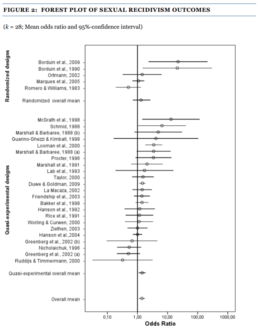Sexual offender treatment programmes
Schmucker and Lӧsel (2017) carried out a systematic review of treatments which aimed to reduce the reoffending rates of sexual offenders. 27 experimental and quasi-experimental studies were included in the review, which comprised of data for 4,939 treated and 5,448 untreated convicted sex offenders from seven different countries.Overall the review suggests that treatments can be effective, with the mean effect of all treatments representing a 26.3% reduction in recidivism for those treated, compared with untreated individuals. The treatments evaluated across the 27 included studies are not directly comparable due to differences in method and implementation, and therefore the review was unable to form a conclusion about the effectiveness of sexual offender treatment programs in general.
Studies reviewed
Average impact
Certainty of impact
Cost
System readiness
What is it?
Sexual offending is a topic of ‘particularly high concern’ to a range of stakeholders (Schmucker and Lӧsel, 2017), with this concern extending to the implementation of treatment programs for offenders, and their effectiveness. Schmuker and Lӧsel (2017) state that treatment of sexual offenders is complicated due to the numerous types of sexual offences and broad range of offender characteristics. For example, these may include offences such as child molestation or viewing child pornography, or underlying causes such as serious neurological disorders. Each of the different types of offense may require different specific treatments. However convicted offenders are being treated as a ‘one size fits all’, usually with cognitive behavioural therapy and medication.
Should it work?
Although treatments used with perpetrators of sexual offences (e.g. cognitive-behavioural and psychosocial interventions) may have strong theoretical and empirical support for their application with broader and non-criminal populations (e.g. towards facilitating cognitive, affective and behavioural change), the origins and causal mechanisms of sexual offending are ambiguous (Mann et al., 2010 cited by Schmuker and Lӧsel, 2017). Consequently, the mechanisms of treatment action and treatment effectiveness may be less certain amongst sex offenders. Most (20) of the studies focused on cognitive-behavioural (CBT) interventions that targeted behaviours, and the rest of the studies on interventions that were medication-based and psycho-social treatment programmes. The review authors did not provide a detailed explanation of whether the treatments should or should not work.
Does it work?
The studies tended to focus on specific treatments for specific issues (e.g. violent recidivism), with not all studies reporting levels of general recidivism. The positive effect size was much greater for these specific types of recidivism than for general recidivism, and the review authors suggest that if all of the studies had evaluated general recidivism then the significant result for this outcome measure may not have been observed.
The 20 comparison studies that evaluated CBT interventions were found to have a significant, albeit small, positive effect overall. However no other types of treatment were found to have a positive effect. Only one randomised trial was conducted using CBT as the treatment method, and this was not found to have a significant effect on recidivism.
How strong is the evidence?
More than half of the 27 studies came from North America and Canada, hence there is a bias towards treatment methods used in these countries, although there were also studies from five other countries. The treatments were carried out over a period of between 8 weeks and 281 weeks, although in nine of the studies, details of the length of treatment was not available. The lack of consistency over timeframes of treatments means that it is difficult to compare recidivism rates after particular time periods.
Only six of the studies included in the review used randomised designs, thus offering strong levels of causal inference. The majority of studies did not employ randomised assignment to treatment, and although they are consistent with the methodology of this website (representing levels 3 and 4 of the Maryland scale), we can be less certain about the relationship between treatment and the reported outcomes. Sample sizes and types of treatment also varied between studies and it is therefore difficult to ascertain the true effect of sexual offender treatment programmes in general.
Is it worth it?
There was no mention of the cost of treatments and therefore cost-effectiveness was not taken into account.
Can it be implemented?
The review did not specifically address the considerations to be made when implementing treatment programmes for sex offenders. Nonetheless, the fact that these programmes exist, and are prevalent, suggests that implementation does not encounter significant barriers.
What’s missing from the evidence?
Although the review was published in 2017, the included studies were published prior to 2010, and the majority of the evaluations were carried out in North America. The research in these studies is consequently dated and not representative of sexual offender treatment programmes implemented worldwide. Whereas many of findings of the included studies may be statistically significant, the lack of data based on the most robust research designs mean that there is not enough evidence of any kind to make a clear causal inference about the effects of treatment programmes. Therefore, as suggested by Schmucker and Lösel (2017), more quality randomised and quasi-experimental studies need to be undertaken to provide more evidence on which confident inferences can be made.
Graphic representation

Schmucker and Lӧsel (2017)
References